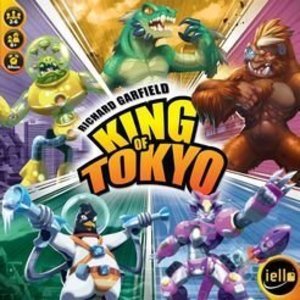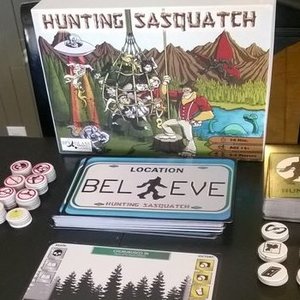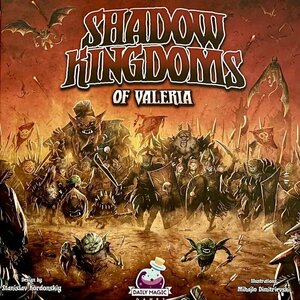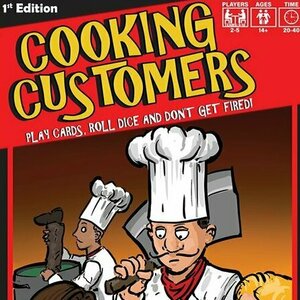
Cooking Customers
Tabletop Game
Play cards, roll dice and don't get fired! In Cooking Customers you will need to hire cooks to...
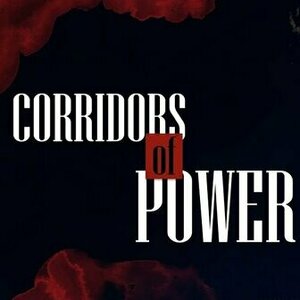
Corridors of Power
Tabletop Game
Corridors of Power is a social game on the heavier side, with a political theme, in which players...
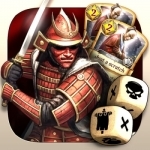
Warbands: Bushido
Games and Entertainment
App
Warbands:Bushido is an online miniatures board game with cards, miniatures, dice and beautiful...
Ben (262 KP) rated King of Tokyo in Tabletop Games
Aug 4, 2019
Purple Phoenix Games (2266 KP) rated Hunting Sasquatch in Tabletop Games
Jan 30, 2021
Hunting Sasquatch is a competitive press-your-luck card and dice game where players are attempting to gather clues to catch Sasquatch. The winner will be the player with the most Victory Points at the end of the game, if any VP are to be had before too many Hunters go missing in the woods.
DISCLAIMER: We were provided a prototype copy of this game for the purposes of this review. These are preview copy components, and I do not know for sure if the final components will be any different from these shown. Also, it is not my intention to detail every rule in the game, as there are just too many. You are invited to download the rulebook, back the game through the Kickstarter campaign, or through any retailers stocking it after fulfillment. -T
To setup shuffle the Location cards (big ones) and reveal as many locations as are players. Shuffle the Hunter cards and deal three to each player. Shuffle the Hunter’s Arsenal cards and place its deck near the Hunter deck on the table. Separate the various tokens by type and place them on the table nearby as well. Have the dice accessible to all players and the game may begin!
On a turn the active player will choose one of their Hunters to visit a Location. The Hunter may visit one of the face-up Locations or draw one to be placed on top of one of those revealed. If the Hunter draws a new Location they MUST visit this newly-revealed Location.
The Hunter then rolls all eight of the green Hunter Dice. If the Hunter had gained any Anti- tokens (anti-camera, anti-book, etc) then those Anti- tokens cause matching dice to be removed from the turn immediately. The Hunter may now spend any Wildcard Tokens they may have earned previously to rotate a die’s value to anything wished.
Once the roll is ready to be resolved, the Hunter will reference the Location they chose for dice values. Each Location has Lost Conditions on the left and Victory Conditions on the right of the card. The Hunter must fill as many Lost Conditions as they have matching dice, and may then assign Victory Conditions dice to their places on the card. Should a Hunter fill up the Lost Conditions spaces with dice the Hunter is then lost to the hunt and their Hunter Card is discarded. Should the Hunter avoiding becoming lost and fill up the column of Victory Conditions they will score the booty from the box in the lower right-hand corner of the Location card (mostly VP, Evidence Tokens, Wildcard Tokens).
If neither column of icons on the Location Card have been filled completely and there are still dice available, the black Fate Die may be rolled. A successful Fate Die roll shows a lucky horseshoe and allows the Hunter to re-roll the available dice. An unsuccessful Fate Die roll shows a bear trap icon and forces the Hunter to apply the Trap conditions on the lower left-hand corner of the Location Card (usually Anti- tokens).
The game ends once a certain number of Hunters are lost (depending on number of players) or once any Hunter has collected all five Evidence Tokens.
Components. Again, this is a prototype copy of the game, so components will most likely be different as a result of a successful Kickstarter campaign. That said, I can comment on the direction the game is going, and I like it quite a bit. The tokens will need to be improved to be more usable, and obviously the dice will upgraded, but other than those I like everything else going on here. The cards are nice, easy to read, and have great artwork on them. Similarly the Location Cards are probably my favorite components of the game because they feature hilarious and wonderful artwork. The game looks great as is, but I am eagerly looking forward to what it will be once completely finished.
The gameplay is kind of a crapshoot in my experience. I have had several plays where too many Hunters were lost too quickly and the game ended in five minutes. I have also played games where Lady Luck was on my side and I was rolling like a king. I managed to get three Evidence Tokens that time. Each one of my games have ended in surpassing the total number of Hunters lost, but I feel like the game is winnable. Just probably by someone luckier than me.
I do really love dice games, and when they allow players to alter the face values, or the game alters them I find a great deal of satisfaction. And that is what Hunting Sasquatch delivers. It is a dice chucking game with dice alteration, amazing hilarious art, and a pretty tough difficulty level. It is perfect for gamers who enjoy dice games but find most to be too lame and easy.
I love this theme. I love this art style. I love the gameplay. I do not love the tiny and thin tokens (but I pray they get a huge upgrade for the final version). Hunting Sasquatch is another winner from Spyglass Games, who brought us the incredible VENOM Assault. I am a big fan of the games this publisher is putting out there and if you are like me, I think you will also like this one a lot. I invite you to check out their Kickstarter campaign when it launches, and remember: cryptids are just made-up stories. They cannot come to your campsite and eat all your jerky.
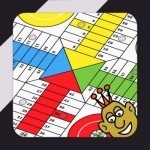
El Parchís
Games
App
Parchís is one of the most popular board games in Spain. It is an adaptation of the Indian game...
Purple Phoenix Games (2266 KP) rated Cooking Customers in Tabletop Games
Feb 4, 2020
DISCLAIMER: We were provided a copy of this game for the purposes of this review. This is a retail copy of the game, so what you see in these photos is exactly what would be received in your box. I do not intend to cover every single rule included in the rulebook, but will describe the overall game flow and major rule set so that our readers may get a sense of how the game plays. For more in depth rules, you may purchase a copy online or from your FLGS. -T
Cooking Customers is a card and dice game where the first player to amass $20 in “tips” will be crowned the winner. Players earn tips by serving enough meals to customers at each table. Players can receive meals by rolling them on dice, or by card manipulation. Let me explain.
To setup, place the meals (black discs) in the middle of the table for all to reach. Similarly, place all the dice nearby. These dice have three sides: FIRED, MEAL, and a blank side. Shuffle the mighty deck of cards and deal five to each player, placing the rest of the deck in the middle of the table. Finally, shuffle the Table cards and place somewhere near the other components. Players are now ready to begin!
On a player’s turn, they will first draw the topmost Table card to be placed in front of themselves. This card will show how many meals need to be served to it to be satisfied and earn tips. The Table cards will mostly just sit there in front of players collecting meal discs for the game’s duration. Once a Table card is drawn (and only one Table per player, please) the active player may then play cards from hand. A player may play one or two cards, but only one card may be played to the active player’s tableau, and only one card may be played on an opponent. Should a player not wish to play a card to anyone’s tableau, they must discard a card to the middle of the table. Then the active player will draw back to the hand size of five cards.
Cards played to other players are usually bad, Munchkin-esque cards that halt progression or just cause mayhem for their designs. I will not go into detail on these, as half the fun of this game is the Take-That of these cards. Cards played to a player’s own tableau can be a myriad choices: Cooks, Helpers, Kitchen Supplies, etc. The most important are the Cook cards. A player will need to have a Cook “hired” in front of them in order to participate in the next phase of the game: rolling dice. Players can have Helper cards (sous chefs) and Kitchen Supplies active without a Cook, but the player may not roll dice or serve meals without a Cook. Cooks and Helpers will dictate how many dice are rolled in the next phase of a turn, and rolling more dice is always better.
Once all cards have been played on a player’s turn, they may now roll the dice (though for a game with such a dark theme I say we use the “Roll Them Bones” colloquialism). When the dice are rolled, players are hoping for MEAL to show up on all dice. This is how a meal can be collected and served to the Table cards. However, if at any time all dice read FIRED then the player’s Cook is fired and they may not continue rolling dice. The Cook is discarded and play is forfeited to the next player. #cheflife amirite?
Once a Table card has all the meals it needs to be satisfied, the player may score it by flipping it over to reveal the amount in tips they have earned. Play continues in this fashion until one player has earned $20 in tips. They can then taunt the other players with their superiority.
Components. Cooking Customers is a BUNCH of cards, some painted wooden discs, and some embossed dice. The cards are good quality, the discs are good as well, and the dice are great. All the components are pretty darn good. The art, though gross at times, is really well-done (see what I did there) and kept us laughing throughout our plays.
I do have one qualm about this game: the rulebook. Though only six pages long and with lots of illustrations throughout, I found that reading it made me more confused than it should have. I did take the rulebook’s advice to go to the publisher’s website, goodenoughgames.com, and watch the rules explanation and playthrough. That helped immensely to clear up what the rulebook did to my brain.
All in all, we had a great time playing this one. We all like Munchkin, and though it is NOT Munchkin, Cooking Customers delivers a take-that dice and card game that really is worth checking out. If you are looking for something with a new theme that plays quickly and has some meat on its bones (and there), then we certainly recommend Cooking Customers. Purple Phoenix Games gives this one a hearty (food puns are too easy) 13 / 18. You can purchase a copy at goodenoughgames.com currently. While you’re there please watch the video.
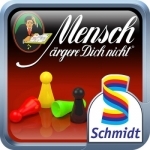
Mensch ärgere Dich nicht!
Games and Entertainment
App
The one and only mobile version of the most popular board game in the world is now better than ever!...

Scratch - Lucky Lottery Games
Reference and Utilities
App
Do you like to play scratch cards? Here! You can just scratch it off and win a Big Prize! Win...
Purple Phoenix Games (2266 KP) rated Shadow Kingdoms of Valeria in Tabletop Games
Jan 5, 2022
Shadow Kingdoms of Valeria is a game of worker placement and dice drafting/pool building in which players are trying to amass the most VP by the end of the game. Played over a series of rounds, players will take turns moving their Warden, drafting dice, and performing various actions. To setup, place the main board in the center of the play area. Shuffle and place the Battle Plan deck, Award cards, and Champion decks in their corresponding locations. Fill the dice bag with the requisite number of dice for your player count, and draw/roll/place the listed number of dice in each of the 5 Shrines (areas) of the main game board. A specified number of Gems are placed in the appropriate Shrine, and each player places their score marker on the 0 space of the score track. Each player receives a player board, random Campaign Map, Warden and Conquest Markers in their chosen color, as well as markers for Gold, Influence, and Magic. Choose a starting player, and the game is ready to begin! The setup for a 2-player game is pictured below.
On your turn, you will move your Warden from its current location to one of the other 5 locations on the board. Whichever location you choose dictates what actions you may take this turn, and are as follows: Gem Shrine, Magic Shrine, Champions Shrine, Gold Shrine, Tactics Shrine, or your own Camp. When placing your Warden at any location (with the exception of your own Camp), you will first select one of the dice found at that Shrine and place it on an open space of your player board. You may not move to a Shrine if it has no dice! After taking a die, you may perform the action associated with your chosen location. The Gem Shrine allows you to take 1 Gem, which can be used to manipulate dice in future turns. At the Magic Shrine, you may gain 2 Magic or claim 1 Award card. Magic can be spent in the game to manipulate dice or partially refresh the Champion/Battle Plan decks, and Award cards give you VP and can be claimed once you have met their requisite conditions. The Champions Shrine grants you the opportunity to buy a Champion card. Champions can provide either Immediate, Ongoing, or End-Game effects. The Gold Shrine allows you to gain Gold (used to purchase Champions and Battle Plans), and the Tactics Shrine allows you to buy a Battle Plan to be placed in your reserve on your player board.
The final location, your own Camp, is on your player board. When you place your Warden here, you are committing to perform a Battle. To do so, select which Battle Plan you wish to complete (either from your reserve, or pay Gold to buy directly from the Battle Plan line), and place it on your player board. All Battle Plans have certain dice requirements that need to be met in order to be completed. Select and manipulate which dice you want to use for your chosen Battle Plan, and add up your total Strength. Compare your Strength to your Influence marker – the lower of the two will be your total strength for this battle. Check the chart on your player board to find the number of VP you earn for the total Strength level achieved in the Battle, and immediately move your score marker the appropriate number of spaces. After performing a Battle, you get to level up your player board. During the game setup, each player receives 10 Conquest Markers that are housed on their player board, blocking/locking certain bonuses, abilities, and dice slots. After a Battle, you may remove 1 Conquest Marker from your player board (granting you a new bonus/ability for future turns), and place it on your Campaign Map. Campaign Maps have nine different slots that will grant you differing rewards. Once you have moved your Conquest Marker, return all dice used in this Battle to the dice bag, and move your completed Battle Plan card to the side of your player board. Your turn then ends and the game moves to the next player.
The game continues in this fashion, with players moving their Wardens, collecting dice, and performing actions, until one player has completed their 7th Battle Plan. The round continues until all players have had an equal number of turns, and then players add up any remaining VP. The player who has accumulated the most VP is then declared the winner!
It really should come as no surprise to you that I love this game. Beyond just the Valeria-verse theme, though, the gameplay is more strategic than I originally thought. Yes, it’s a worker placement and dice drafting game, but the underlying strategy is really what makes it great. You see, the dice in the game have 3 different elements that affect your strategy. First is the color: each color matches a Faction, and different Factions are required to complete specific Battle Plans. Next, is the actual die value: you want higher numbers to get a higher Strength, which equates to more VP when completing Battle Plans. And lastly is the discount: depending on the face value of the die, you will receive a discount towards purchasing Champions, Battle Plans, or collecting gold. The lower the face value of the die, the higher the discount, and vice versa. So yeah, maybe taking a 1 value die won’t really help in the Battle Plan, but the amount of gold it allows you to collect might be worth it. You have those 3 things to consider for dice alone! And that doesn’t even take into account which Champions you might want to buy, or what Battle Plans would be beneficial to you.
Another neat strategic element are the Conquest Markers on your player board. Everyone starts with the same number/placement of Conquest Markers, but as the game progresses, players may resolve them in various ways. There is no ‘correct’ order in which to move Conquest Markers – it all comes down to your strategy. Maybe you want more dice right off the bat, so you remove those first. Or maybe you want to be able to reserve more than 1 Battle Plan at a time, so you go for that one. It’s going to be different for every player, and it’ll be different every game. It all depends on the layout of the main board, and which dice and actions are available to you at any given time. There are so many strategic considerations throughout the entire game, and it keeps all players actively engaged.
Components. No surprise here, but the component quality is great, which is to be expected of Daily Magic Games. The cardboard is all thick and chunky, the wooden tokens nice and sturdy, and the cards are easy to manipulate and clear to read. The artwork is, in my opinion, one of the greatest things about the Valeria games, and Shadow Kingdoms is no exception. When getting the game set up, sometimes I find myself just looking through the cards and really appreciating the artwork. So all in all, great production quality here.
Does Shadow Kingdoms of Valeria climb the ranks to my favorite Valeria game? Not quite, but I have to say honestly that it’s getting there. The gameplay is solid and straightforward, the strategic implications are vast, and the components make the game feel awesome. And to get the Monster perspective in this universe is a neat twist that I otherwise would not really have thought of. If you’re a fan of the Valeria games, definitely check this one out. Or if you’re just a fan of worker placement, with some unique elements of drafting, then I highly recommend this one as well. Purple Phoenix Games gives it a mighty 5 / 6. Check it out. I don’t think you’ll be disappointed.
